The global hydrogen peroxide market is estimated to be valued at USD 3.55 Bn in 2024 and is expected to reach USD 5.02 Bn by 2031, growing at a compound annual growth rate (CAGR) of 5.1% from 2024 to 2031.
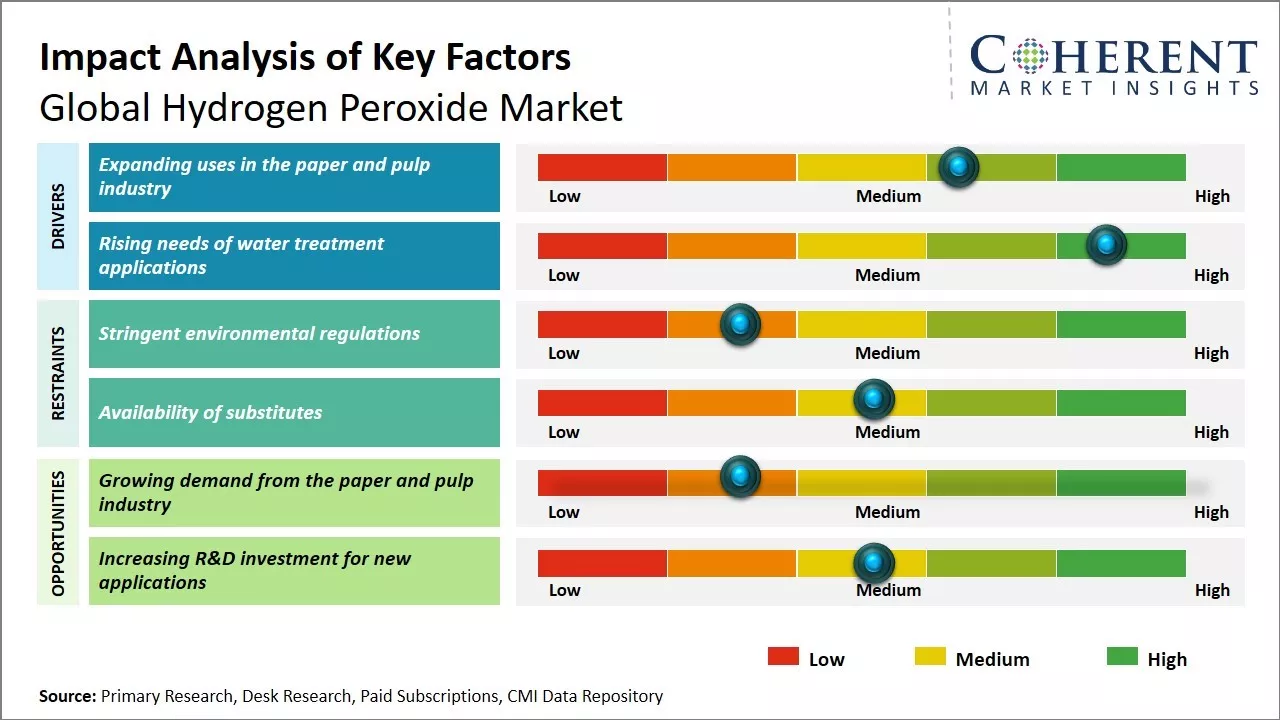
Discover market dynamics shaping the industry request sample copy
Factors such as increasing demand from end-use industries including pulp & paper, chemical synthesis, and water treatment, coupled with growth in the personal care and healthcare industries will drive the market growth. Additionally, rapid industrialization and urbanization in emerging economies have increased the demand for wastewater treatment, which requires hydrogen peroxide. Also, increasing adoption of hydrogen peroxide as an environment-friendly bleaching agent in the pulp & paper industry is further expected to propel the market growth.
Expanding uses in the paper and pulp industry
The global hydrogen peroxide market has been witnessing steady growth over the past few years due to its expanding applications in the paper and pulp industry. As one of the largest end-use sectors, the paper and pulp industry utilizes hydrogen peroxide for bleaching papers and removing wood lignin content. The usage of hydrogen peroxide for bleaching has various environmental benefits as compared to traditional chlorine-based methods. It leaves no residues and breaks down into water and oxygen, thus reducing pollution. With growing awareness about sustainability, more paper manufacturers are switching to hydrogen peroxide for their bleaching needs. Additionally, demand for higher-quality bleached paper grades is rising globally with the development of the packaging and tissue paper segments. Customers prefer bright and vibrant packaging for marketed products along with soft and bright tissue papers. As hydrogen peroxide allows achieving desired shade and brightness levels efficiently, its dependence is deepening within the papermaking sector. For example, recent data from the European Commission shows that over 60% of paper mills in Europe have already adopted hydrogen peroxide partially or fully for bleaching. This transition is likely to continue as sustainability becomes a key business priority. Future projections by the Food and Agriculture Organization (FAO) also favor market growth. The FAO report estimates world demand for paper to increase by over 40% between 2020 and 2030 driven by the global middle-class population expansion. With this sharp rise, pulp and paper mill capacities are expected to simultaneously strengthen. This would translate to augmented hydrogen peroxide needs for bleaching the additional paper production over the coming decade. Thus, expanding applications as an eco-friendly bleaching agent for the steadily growing paper industry will remain a key factor driving the global hydrogen peroxide market in the near future.
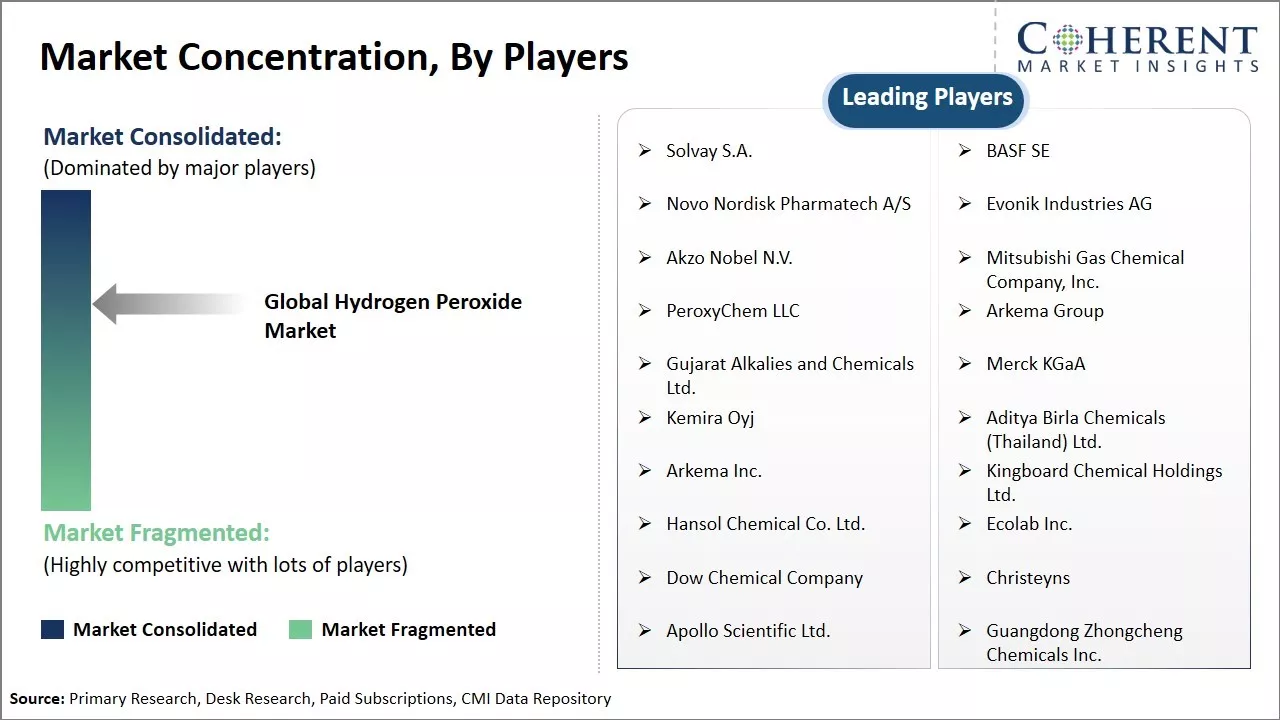
Get actionable strategies to beat competition: Get instant access to report
Rising needs of water treatment applicationsClean and safe water is crucial for industries, communities as well as populations at large. With growing concerns about water pollution and contamination of water bodies, there is heightened focus on advanced purification of water supplies. Hydrogen peroxide has emerged as a workhorse chemical for treating wastewater discharged from varied industries before its disposal. It helps remove toxins and neutralize pathogens. Similarly, drinking water treatment plants too are leveraging hydrogen peroxide to sanitize and disinfect water. This ensures high-level safety. Its properties of decomposing into water and oxygen without forming any harmful residues make it an environment-friendly disinfectant. Additionally, many municipal corporations in urban areas are installing hydrogen peroxide producing units for decentralizing water treatment activities. Thus, the rapidly expanding water treatment infrastructure and rising focus on recycled water utilization are fueling the demand for hydrogen peroxide in this strategically important application sphere.
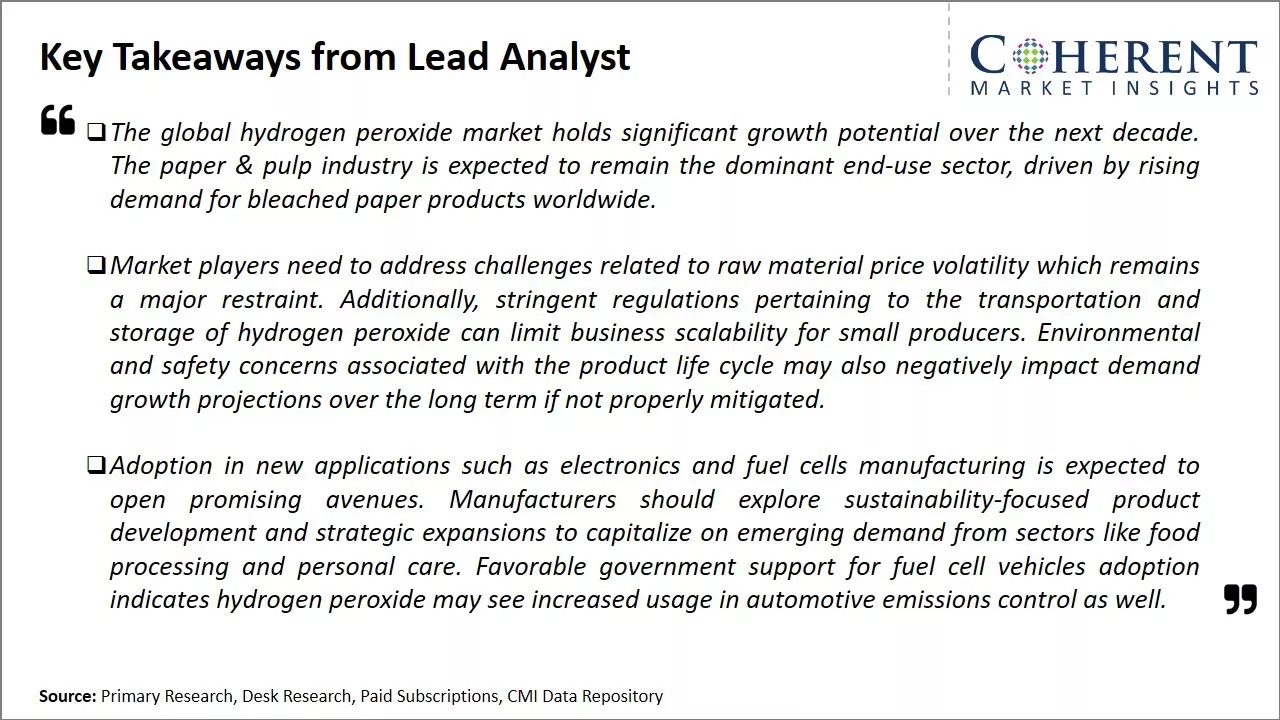
To learn more about this report, request sample copy
Challenges: Stringent environmental regulationsStringent environmental regulations regarding industrial emissions are forcing companies to invest heavily to upgrade their production facilities and control systems. Growing availability of substitutes like ozone and chlorine is also threatening market share. Additionally, Supply chain disruptions due to the pandemic have put further pressure on producers and disrupted prices. Rising raw material costs are squeezing margins. There is uncertainty regarding geopolitical issues that could impact energy supplies needed for hydrogen peroxide manufacturing.
Opportunities: Growing demand from the paper and pulp industry
Growing demand from the paper and pulp industry is increasing as paper production rises globally. Additionally, The pharmaceuticals and personal care sectors also offer promise as hydrogen peroxide finds more applications in these fields. Opportunities exist in wastewater treatment plants to utilize hydrogen peroxide for disinfection.
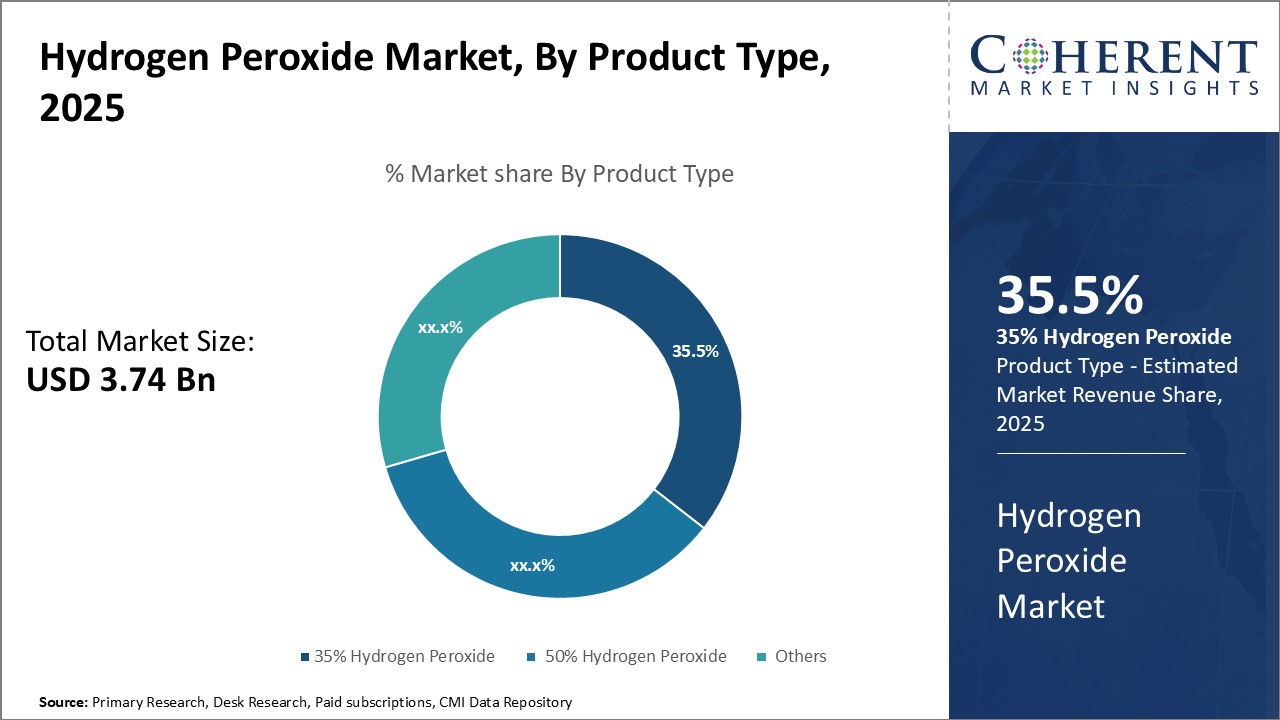
Discover high revenue pocket segments and roadmap to it: Get instant access to report
Insights, by Product Type: Efficiency and Versatility Drive the Demand for 35% Hydrogen PeroxideIn terms of product type, 35% hydrogen peroxide contributes 52.3% of the market share in 2024 of the market owing to its widespread applications and effectiveness. Compared to higher concentration products, 35% hydrogen peroxide offers an optimal balance of bleaching power and cost-efficiency for various industrial and consumer uses. Its mild formulation allows for the safe and gentle bleaching of textiles and paper goods without degrading fabrics or fibers. Additionally, the 35% concentration works well as a disinfectant for surface cleaning in healthcare facilities, laboratories, and food processing plants due to its ability to deactivate a broad spectrum of microbes. Its versatility has also led to the growing use of 35% hydrogen peroxide in personal care products as a cleansing agent and in green cleaning products as a non-toxic alternative to chlorine bleaches.
Insights, by Function: Dominant Role in Bleaching Driving 50% Hydrogen Peroxide Demand
When considering function, bleaching contributes 35.3% of the market share in 2024 due to the importance of hydrogen peroxide in bleaching applications. The 50% hydrogen peroxide concentration in particular is widely used for industrial bleaching where high oxidizing power is required to intensely lighten colors in paper pulp and treated textiles. Its elevated peroxide content allows it to quickly and effectively bleach large volumes of materials. Additionally, 50% hydrogen peroxide minimizes bleaching cycle times and improves overall production efficiency for manufacturers. It causes less damage to fibers and fibers and permits better process control compared to chlorine-based bleaches. These advantages have made 50% hydrogen peroxide critical for sustainable and large-scale bleaching in industries such as paper manufacturing.
Insights, by Application: Versatile Oxidizing Properties Boost the Hydrogen Peroxide Demand in the Pulp and Paper Industry
When considering application, pulp and paper contribute 34.6% of the market share in 2024 due to hydrogen peroxide’s suitability for the key steps in the pulping process. Particularly, its use is driven by the chemical’s powerful abilities as an oxidizing agent and bleach for pulp and paper manufacturing. Hydrogen peroxide boosts the delignification of wood chips during pulping by weakening lignin bonds to remove color bodies. Additionally, its stable form allows for direct addition to pulp slurries without the generation of undesirable byproducts. This makes it compatible with elemental chlorine free and totally chlorine free bleaching sequences. Furthermore, hydrogen peroxide results in brighter, higher quality pulp and paper through its selective oxidation and functional group stabilization. These benefits have cemented hydrogen peroxide as a core part of sustainable and economically viable pulping and bleaching technologies.
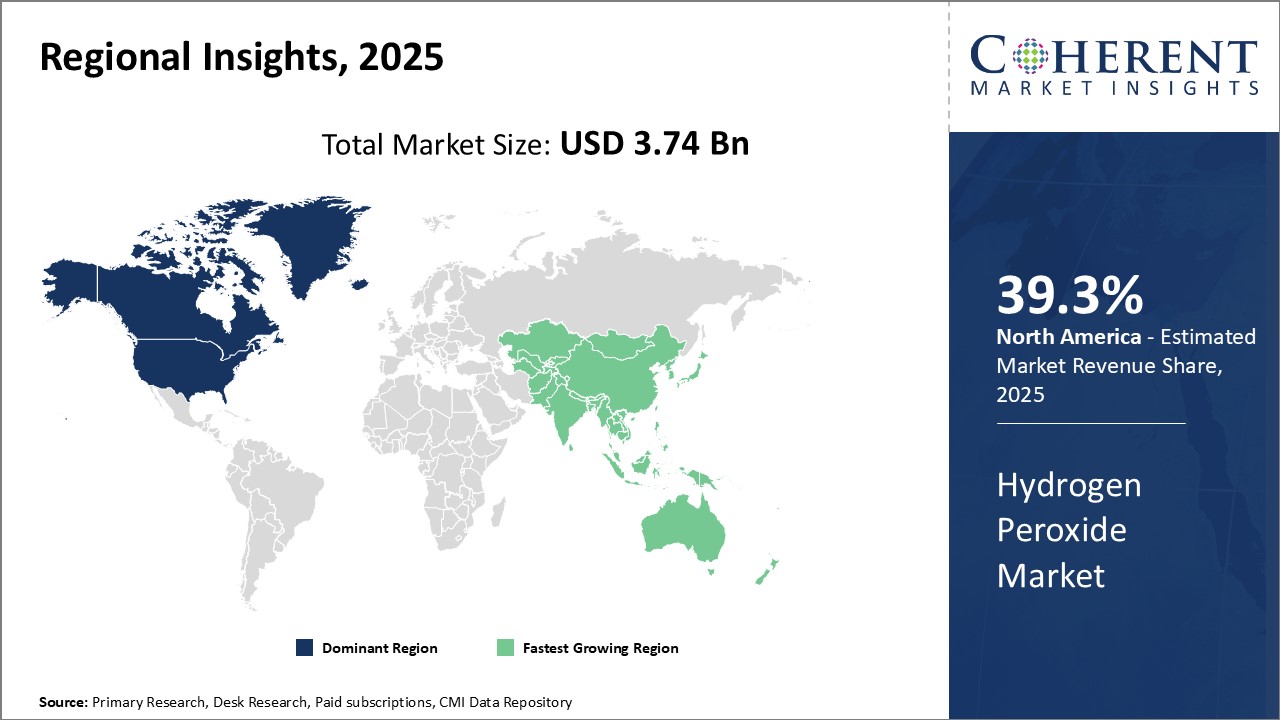
To learn more about this report, request sample copy
North America has established itself as the dominant region in the global hydrogen peroxide market over the past few decades with 38.8% share in 2024. The major factors contributing to its leading position are a strong presence of manufacturing facilities of top players and a well-established end-use industries base. The U.S., in particular, is home to two of the world's largest producers of hydrogen peroxide which cater to both domestic and international markets. Moreover, the North American paper industry is one of the largest consumers of hydrogen peroxide globally. This constant demand from the paper industry and other end-use sectors such as chemical synthesis and wastewater treatment have ensured steady revenues and growth for hydrogen peroxide producers in the region.
However, with the North American market approaching saturation, players are looking at other emerging regions for future expansions. In this regard, Asia Pacific has emerged as the fastest growing regional market. The primary factor driving the demand in Asia Pacific is rapid industrialization and strong economic growth in countries such as China and India. Both countries have seen tremendous capacity additions in end-use industries like pulp & paper and textiles over the past decade which has translated to an increased consumption of hydrogen peroxide. Apart from domestic consumption, the region is also emerging as an export and production hub. Relatively lower manufacturing costs have encouraged global leaders to set up manufacturing units to cater not only to the local markets but also export to other regions. This has made Asia Pacific an attractive investment destination for hydrogen peroxide producers seeking future growth opportunities.
Hydrogen Peroxide Market Report Coverage
| Report Coverage | Details | ||
|---|---|---|---|
| Base Year: | 2023 | Market Size in 2024: | US$ 3.55 Bn |
| Historical Data for: | 2019 To 2023 | Forecast Period: | 2024 To 2031 |
| Forecast Period 2024 to 2031 CAGR: | 5.1% | 2031 Value Projection: | US$ 5.02 Bn |
| Geographies covered: |
|
||
| Segments covered: |
|
||
| Companies covered: |
Solvay S.A., BASF SE, Novo Nordisk Pharmatech A/S, Evonik Industries AG, Akzo Nobel N.V., Mitsubishi Gas Chemical Company, Inc., PeroxyChem LLC, Arkema Group, Gujarat Alkalies and Chemicals Ltd., Merck KGaA, Kemira Oyj, Aditya Birla Chemicals (Thailand) Ltd., Arkema Inc., Kingboard Chemical Holdings Ltd., Hansol Chemical Co. Ltd., Ecolab Inc., Dow Chemical Company, Christeyns, Apollo Scientific Ltd., and Guangdong Zhongcheng Chemicals Inc. |
||
| Growth Drivers: |
|
||
| Restraints & Challenges: |
|
||
Uncover macros and micros vetted on 75+ parameters: Get instant access to report
*Definition: The global hydrogen peroxide market consists of companies that produce and supply hydrogen peroxide and its related derivatives to various industries including paper & pulp, chemicals, wastewater treatment, mining, and others. Hydrogen peroxide is a colorless liquid which primarily acts as an oxidizing agent and bleaching agent. It has applications across industries for chemical synthesis, cleaning, and disinfection purposes.
Share
About Author
Vidyesh Swar is a seasoned Consultant with a diverse background in market research and business consulting. With over 6 years of experience, Vidyesh has established a strong reputation for his proficiency in market estimations, supplier landscape analysis, and market share assessments for tailored research solution. Using his deep industry knowledge and analytical skills, he provides valuable insights and strategic recommendations, enabling clients to make informed decisions and navigate complex business landscapes.
Missing comfort of reading report in your local language? Find your preferred language :
Transform your Strategy with Exclusive Trending Reports :
Frequently Asked Questions
Joining thousands of companies around the world committed to making the Excellent Business Solutions.
View All Our Clients